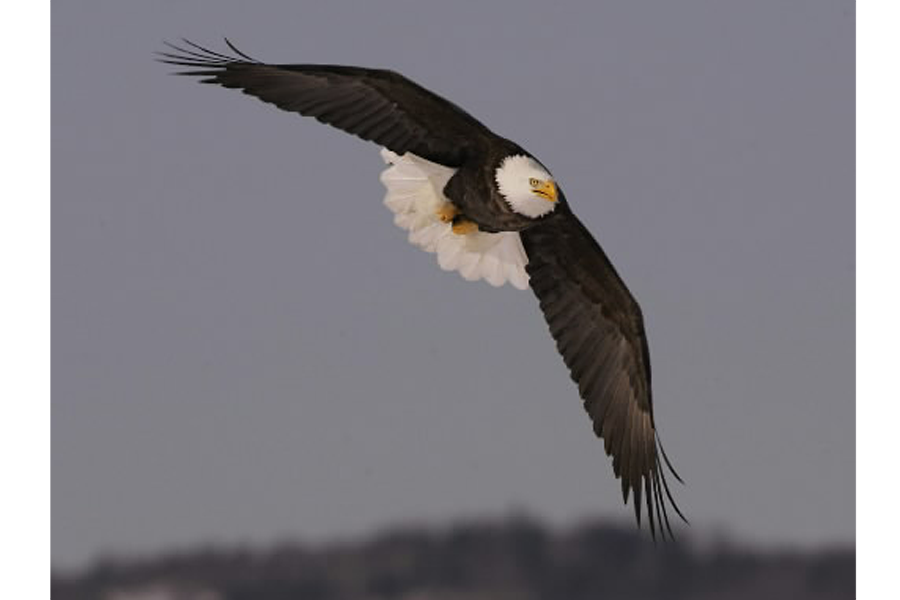How soaring birds might inspire intelligent, gliding machines
Loading...
Sometimes the best inspiration lies in plain view.
High up in the sky some birds appear to fly without flapping their wings, just gliding along.
They're catching rides on pockets of air, allowing them to soar along without expending much energy. And scientists are studying how these birds learn such sophisticated soaring in search of insights that could revolutionize how machines learn to fly. If the researchers devise algorithms to mimic the birds' ability to learn, drones and other flying vehicles could also become smarter and more nimble.
When a bird like a vulture, eagle, or hawk is gliding along, they simply have to adjust the angle of their wings to catch rising currents of hot air – called thermals – to maintain altitude or soar a little higher.
But this hot air doesn't rise evenly. "There are some parts that are going up, some parts that are going down," and it's not all at the same speed, explains Terrence Sejnowski, a computational neurobiologist at the Salk Institute for Biological Studies in La Jolla, Calif. The birds have to compensate for this turbulence to avoid plummeting.
But "conditions can change instantaneously," Dr. Sejnowski tells The Christian Science Monitor. "You can't predict perfectly what's going to happen next."
With such a plethora of conditions they might encounter, the birds likely haven't experienced every possible condition, and probably lack a preset way to respond to each particular moment of turbulence. So the way they respond has to be generalized, assessing the various different characteristics of the environment and adjusting accordingly.
To learn how to navigate such a dynamic scenario, and determine how to ride, the birds have to calculate a complex set of sensory input.
Scientists thought the birds might be using the temperature of the rising hot air to figure out how to maneuver their bodies to catch the ride just right. But it turns out that two other sensory inputs are more important.
How fast the hot air is rising, and the torque – pressure on the birds' bodies to rotate away from an upright position – likely influence what adjustments the birds make most, according to a paper published Monday in the journal Proceedings of the National Academy of Sciences.
It's been a "complete unknown" how birds learn to soar in turbulence, Douglas Warrick, a biophysicist at Oregon State University who was not part of this study but also studies aerodynamics, tells the Monitor. Anecdotes suggest that juvenile birds have a harder time dealing with the turbulent environment, but "nobody has ever been able to watch young animals, or inexperienced animals, in their first attempts" in a scientific way.
So Sejnowski and his colleagues took a different tactic.
The team created a computer model of the turbulence a gliding bird might encounter and then taught their simulated bird to fly using an algorithm called reinforcement learning.
All species employ reinforcement learning, says Sejnowski, to learn to navigate their environment based on experience. For example, a juvenile bird might notice that if there's certain degree of torque, a particular adjustment will help keep their bodies upright. In future scenarios, they'll base their response on that experience.
"That's a sophisticated thing to program," Dr. Warrick says. "And this was the first attempt that I've ever seen at getting to the problems of it. I think it's a nice exercise."
For birds, "the key is learning what to ignore," he says. What degree of turbulence can the birds ignore and what do they need to respond to?
"If you watch birds learning to fly in a windy place," Warrick says, "Well, they start out cautiously, that's for sure."
Determining algorithms that mimic birds learning to glide could help scientists create machines that can learn to soar, too.
One of the challenges with artificial intelligence has been in developing algorithms that can generalize their responses to a variety of scenarios, Sejnowski says. In the past, "they only worked under very specific conditions," he says, "and they failed in the real world because of the complexity of the real world."
But strides are being made. In March, Google's game-playing artificial intelligence program, AlphaGo, defeated the top-ranked human player at the strategy game Go. The feat was accomplished because the Google developers had created AlphaGo to be able to learn how to intuitively pick the optimal moves.
Sejnowski says that his study demonstrates that such learning algorithms that have been employed to solve games can also be used "to solve real world problems that humans and other animals face every day."
One way these algorithms could be applied to real world problems might be to revolutionize drones, Sejnowski says. Right now they are motorized and operated by a human. But if they could be taught to soar like an eagle, taking advantage of the free energy of thermals, drones might be able to be autonomous and use much less energy.
This could be used to improve technologies already in development, like Facebook's solar-powered drone intended to deliver internet to remote areas, Sejnowski points out. If the drone could take advantage of thermals, it could make such a project like that less expensive.
But, "we're talking about a new technology that doesn't exist yet," Sejnowski says. So "you can't predict what the impact is going to be."








